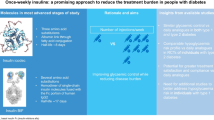Abstract
Objective: The role of the dose and route of administration of octreotide in addition to insulin on daily blood glucose, growth hormone, glucagon, cortisol and adrenaline profiles in 7 insulin-dependent diabetic patients have been studied. Octreotide was administered either as multiple subcutaneous injections (50 μg three times daily, total dose 150 μg) or by continuous subcutaneous infusion of lower 62.5 μg 24/h and 112.5 μg 24/h.
Results:
Blood glucose and growth hormone concentrations were lowered by octreotide in a similar manner regardless of the route of administration and dose. Glucagon concentrations at 12 and 16 h were reduced by all octreotide doses, but fasting at 20, 24 and 04 h concentrations were lowered only by 113 μg given by continuous infusion. Cortisol and adrenaline concentrations were not modified.
Conclusions:
Thus, low doses of octreotide administered by continuous infusion in addition to standard insulin treatment displayed the same hypoglycaemic effect as larger doses given by multiple injections without causing adverse-effects or hypoglycaemic episodes.
Similar content being viewed by others
Author information
Authors and Affiliations
Additional information
Received: 9 November 1995/ Accepted in revised form: 1 May 1996
Rights and permissions
About this article
Cite this article
Lunetta, M., Mauro, M., Moli, R. et al. Effect of octreotide on blood glucose and counterregulatory hormones in insulin-dependent diabetic patients: the role of dose and route of administration. E J Clin Pharmacol 51, 139–144 (1996). https://doi.org/10.1007/s002280050174
Issue Date:
DOI: https://doi.org/10.1007/s002280050174




